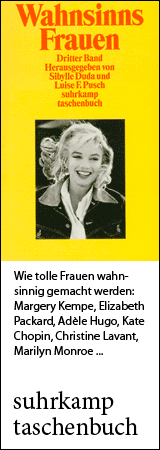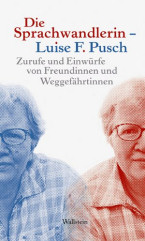
geboren am 16. August 1945 in Cincinnati, Ohio
US-amerikanische Tänzerin, Tanzpädagogin und Choreographin
75. Geburtstag am 16. August 2020
Biografie • Zitate • Weblinks • Literatur & Quellen
Biografie
Die Tanzkritikerin des New Yorker, Joan Acocella, bezeichnete das 45 Jahre alte Amateurvideo als “eines der außerordentlichsten Tanzdokumente, das ich je gesehen habe.” Es zeigt eine junge Frau “... die mit fließender Grazie und zugleich wütender, fast dämonischer Energie tanzte. Angesichts der vertrackten Schrittfolgen, ausgeführt in halsbrecherischem Tempo, fragt man sich, wie eine gewöhnliche Sterbliche sich so bewegen konnte.” (Gewertz 2004)
Die Rede ist von Suzanne Farrell, damals 19 Jahre alt - laut Acocella “die einflußreichste Tänzerin, die Amerika hervorgebracht hat.”
Farrells Mutter zog nach ihrer Scheidung 1959 mit ihren begabten Töchtern von Cincinnati nach New York, um sie zur Pianistin bzw. Tänzerin ausbilden zu lassen. Die Drei bewohnten ein winziges Apartment, das von dem Flügel fast vollständig eingenommen wurde. Nachts schliefen die Töchter in dem einzigen Bett, tagsüber die Mutter. Farrell bekam mit 15 ein Stipendium an der Schule des New York City Ballet (NYCB), das von dem Exilrussen George Balanchine geleitet wurde, dem (laut Farrell) “Ballettgenie des Jahrhunderts”.
Mit 16 wurde Farrell Mitglied des NYCB, und sie war noch nicht 18, als Balanchine sie für Hauptpartien einsetzte. “Während seiner gesamten Laufbahn war Balanchines Arbeitsmethode wie folgt: Er verliebte sich in eine junge Tänzerin, kreierte wundervolle Ballette für sie, manchmal heiratete er sie sogar, und dann wechselte er über zur nächsten jungen Tänzerin.” (Acocella) Farrell beschloß, den 41 Jahre älteren “Mr. B” weder zu heiraten noch mit ihm zu schlafen. Sie hatten eine platonische und daher vielleicht umso intensivere Beziehung. In den 60ern, den sogenannten “Farrell-Jahren” des NYCB, bekam Farrell fast jede Hauptrolle, Balanchine schuf für sie pro Jahr ein neues Ballett, manchmal drei oder vier. Als sie ihren Kollegen Paul Mejia heiratete, wurde Mr. B so unausstehlich, daß sie für vier Jahre zu Maurice Béjart nach Brüssel auswich. Danach vertrug man sich wieder, und von 1975 bis zu Balanchines Tod 1983 waren die beiden wieder das Dream Team des amerikanischen Balletts.
Ende 1989 verabschiedete sich Farrell von der Bühne und ist seither eine weltweit gefragte Expertin für Balanchine-Einstudierungen. Seit 1995 hat sie ihr eigenes “Suzanne-Farrell-Ballet” am Kennedy Center in Washington, DC. Aus der besessenen Tänzerin von einst, die unter ihren KollegInnen am NYCB wegen ihrer Distanziertheit und ihrer Vorzugsstellung verhasst war, ist eine begnadete Lehrerin geworden, die ihre für die Aufführungen immer wieder neu zusammengestellte Truppe zu Höhen führt, die niemand von ihnen erwartet hätte – wie einst Balanchine. Und das alles, ohne mit ihnen zu schlafen.
Verfasserin: Luise F. Pusch
Zitate
Zitate (aus Academy of Achievement):
But what was my motivation was music, and the fact that I love to move around. I'm always moving around. And I think it was important that I learned to love to dance eventually for its own sake, as opposed to wanting to be a ballerina. Because I think it made me realize that there was a lot of hard work involved before you get to be a ballerina. And I never lost loving the actual work that was involved in it.
Let's get back to your beginnings. What were you like as a kid?
Very adventurous. Fearless, which I guess was good, ultimately, in having to get out on stage.
I had a wonderful childhood, coming from Cincinnati, and I think that it was great going into the life that I was going to have, where you have to start young as a dancer. You don't have the opportunity to really lead a normal life, like most young teenagers do. I was very happy that I was as normal as possible before I went into serious dance.
I was grateful that I had dancing to fall back on. It was my survival tactic. It was my friend. It was always there. I could work out a lot of my emotions by going to class and dancing. I never felt lonely.
I liked math. Counting was easy for me, which was good, because a lot of the ballets have involved difficult counts. I liked spelling. I liked anything that has a big problem to solve. History was not too interesting to me. I liked to read but, being a dancer, I didn't have a lot of time to read.
I was very tall as a young girl, and there were no boys in the ballet school. So whenever the recital would come along, I was always the prince, never the princess. I think that's one reason why I wasn't too crazy about ballet in the beginning. I never got those pretty tutus. But of course all that changed.
it wasn't important whether I became famous, I just wanted to be the best that I could be. So you are always in competition with yourself, and not someone else.
Who has most influenced you in your career? Who has had the greatest impact on you?
That's an easy question. It was, of course, George Balanchine. He came from Russia via Europe and settled in America in 1933. He started a little company which was not very successful, so he had to start over and over again. Ultimately, he founded the New York City Ballet. I happened to be born at the right time, came to the right place, and had the fortune to audition for him, and work with him, because he is the genius of the century of ballet. I learned how to dance with him. ••••••••••••••••
Du mußt deine eigene Cheerleaderin sein, mußt deine Motivation selbst erzeugen.
Halt den Kopf hoch. Größe ist eine Illusion. Es kommt nicht darauf an, wie groß du bist.
Es gibt keine Kurse, die dir beibringen, wie man eine Ex-Ballerina ist. Das Härteste bei meinem Ruhestand war, daß ich keine schöne Musik mehr hören konnte, weil ich dann tanzen wollte.
Aus: Gewertz, Ken. 2004. “The grace and wisdom of Suzanne Farrell”, The Harvard Gazette 22.4.04 Übersetzung von Luise F. Pusch
Links
Suzanne Farrell in der Academy of Achievement
Suzanne Farrell auf Kennedy-Center-org
Literatur & Quellen
Acocella, Joan. 2003. “Second Act: Suzanne Farrell's Ballet Company”, The New Yorker 2003.01.06, 48-61.
Dickson, Deborah & Anne Belle. 2001. Suzanne Farrell: Elusive Muse. Video/DVD. Winstar Home Entertainment.
Farrell, Suzanne with Toni Bentley. 1990. Holding on to the Air: An Autobiography. New York. Summit.
Gewertz, Ken. 2004. “The grace and wisdom of Suzanne Farrell”, The Harvard Gazette 22.4.04 (Online unter: www.news.harvard.edu/gazette/2004/04.22/14-farrell.html (15.08.2010))
Sollten Sie RechteinhaberIn eines Bildes und mit der Verwendung auf dieser Seite nicht einverstanden sein, setzen Sie sich bitte mit Fembio in Verbindung.


